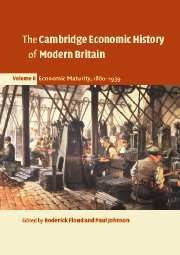Book contents
- Frontmatter
- 1 Long-run growth
- 2 Population and regional development
- 3 Human capital and skills
- 4 Manufacturing and technological change
- 5 The service sector
- 6 Agriculture, 1860–1914
- 7 Trade, 1870–1939: from globalisation to fragmentation
- 8 Foreign investment, accumulation and Empire, 1860–1914
- 9 Enterprise and management
- 10 Domestic finance, 1860–1914
- 11 Living standards, 1860–1939
- 12 The British economy between the wars
- 13 Unemployment and the labour market, 1870–1939
- 14 British industry in the interwar years
- 15 Industrial and commercial finance in the interwar years
- 16 Scotland, 1860–1939: growth and poverty
- 17 Government and the economy, 1860–1939
- References
- Index
- References
2 - Population and regional development
Published online by Cambridge University Press: 28 March 2008
- Frontmatter
- 1 Long-run growth
- 2 Population and regional development
- 3 Human capital and skills
- 4 Manufacturing and technological change
- 5 The service sector
- 6 Agriculture, 1860–1914
- 7 Trade, 1870–1939: from globalisation to fragmentation
- 8 Foreign investment, accumulation and Empire, 1860–1914
- 9 Enterprise and management
- 10 Domestic finance, 1860–1914
- 11 Living standards, 1860–1939
- 12 The British economy between the wars
- 13 Unemployment and the labour market, 1870–1939
- 14 British industry in the interwar years
- 15 Industrial and commercial finance in the interwar years
- 16 Scotland, 1860–1939: growth and poverty
- 17 Government and the economy, 1860–1939
- References
- Index
- References
Summary
INTRODUCTION: POPULATION GROWTH IN THE LONG TERM
Population growth (or in rare cases decline) occurs for one of three reasons: changes in the number of births, changes in the number of deaths and changes in the migration balance. However, simple birth, death and migration rates (e.g. deaths per 1,000 people) are rather crude measures. For example, it is possible for the overall death rate to be rising while deaths at each age are falling. This could occur if the population was ageing – i.e., the number in the older age groups was rising. In this case, improvements caused, say, by improved nutrition, would be masked. Demographers therefore prefer to talk about mortality and fertility, which are defined below and which measure deaths and births holding age structure constant. (The measurement of migration poses some particular problems, which are discussed below.)
The main features of population change between the 1840s and the 1940s are as follows. The population of Great Britain increased by nearly two and half times from 18.5 to 45.8 million. Most of the growth occurred in the cities and suburbs, especially London and the great cities of the north and Midlands. There was considerable migration from the countryside and the more remote the area the more likely that it would be depopulated. Many people left Britain for overseas destinations. Most of them went to the new Europe overseas – countries with a low population density (and high resource/population ratio). These countries were also attracting emigrants from many other parts of Europe. Further, there was a rather smaller flow of immigrants from continental Europe and Ireland into Britain.
- Type
- Chapter
- Information
- The Cambridge Economic History of Modern Britain , pp. 25 - 55Publisher: Cambridge University PressPrint publication year: 2004
References
- 3
- Cited by

